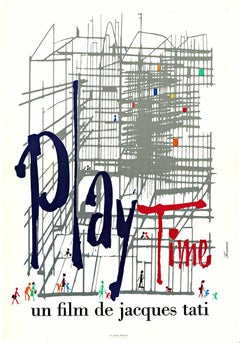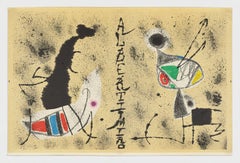René Ferracci Abstract Prints
French, 1927-1982
a.k.a. René Ferracci
René Ferracci was born on November 27, 1927, in Paris, France. He is known for Dear Inspector (1977), The Hot Rabbit (1974), and Fugues à Fugain (1981). He died on February 25, 1982, in France.
Created several French movie posters. Ferracci was like the Ferrari (or Gucci, if you prefer handbags) of French movie poster artists back in the late 1960s — because, at the time, nobody had seen anything like him! Ferracci was one of the early pioneers to introduce photo-montage/collage designs into his posters, mixing color illustrations with black-and-white photography (or vice versa) and offset printing. And it worked out very well for him as Ferracci became a brand name in the movie poster world — as well as a marketing expert in branding — by being one of the first artists to stamp (not sign) his name on each of his posters.to
1
1
Overall Width
to
Overall Height
to
1
5
646
200
166
165
1
1
1
1
1
Artist: René Ferracci
Original "Play Time" vintage smaller format French movie poster
By René Ferracci
Located in Spokane, WA
Original vintage movie poster "PlayTime," directed by Jacques Tati. The artwork is notable for its minimalist and modern design, featuring a stylized depiction of a cityscape with pl...
Category
1960s Abstract René Ferracci Abstract Prints
Materials
Lithograph
$360 Sale Price
20% Off
Related Items
Abstract Figurative Lithograph
By Rico Lebrun
Located in Houston, TX
Black and white figurative abstract lithograph of two naked, crouching figures by California artist "Rico Lebrun," titled "Crouching Figures" and dated 1961. Additional writing on th...
Category
1960s Abstract René Ferracci Abstract Prints
Materials
Lithograph
Spanish artist original 1975 lithograph on canvas book cover for Rafael Alberti
By Joan Miró
Located in Miami, FL
Joan Miro (Spain, 1893-1983)
'Maravillas con variaciones acrósticas en el jardín de Miró (cobertura para el estuche)', 1975
lithograph on canvas
21.5 x 32.25 x 21 in. (54 x 82 cm.)
Edition of 1500
Unframed
ID: MIR2001-014
It is documented in Cramer, P (1992). Miró Litographer V (1972-1975). Maeght Éditeur, pp 162-163. No. 1051.
Artwork history:
At the end of 1971 Rafael Alberti wrote from Rome to Joan Miró in the following terms “(…) I think I have news that you liked my folder...
Category
1970s Abstract René Ferracci Abstract Prints
Materials
Lithograph, Canvas, Ink
$800
H 21.25 in W 32.28 in
Plate X, from Les Songes Drolatiques de Pantagruel
By Salvador Dalí
Located in Washington, DC
Artist: Salvador Dali
Title: Plate X, from Les Songes Drolatiques de Pantagruel
Medium: Lithograph in colors on Japon paper
Year: 1973
Edition: 209/250
Sheet Size: 29 3/4" x 21"
Imag...
Category
1970s Abstract Expressionist René Ferracci Abstract Prints
Materials
Lithograph
$3,295
H 29.75 in W 21 in D 2 in
abstract composition
By Marie Raymond
Located in Belgrade, MT
This color lithograph is part of my private collection since the 1970's. Marie Raymond was a pioneer post WWII painter of her generation. She was a lyrical abstractionist of her time...
Category
Mid-20th Century Abstract Expressionist René Ferracci Abstract Prints
Materials
Color, Lithograph
Alvar Sunol Pencil Signed Lithograph C.1970s
By Sunol Alvar
Located in San Francisco, CA
Alvar Sunol Pencil Signed Lithograph C.1970s
Three women around a table
Dimensions 21.5" wide x 12.5" high
The frame measures 32.75" wide x...
Category
Mid-20th Century Abstract Impressionist René Ferracci Abstract Prints
Materials
Lithograph
Robert Kushner, abstraction for the Paris Review Lithograph hand signed 142//200
By Robert Kushner
Located in New York, NY
Robert Kushner
Paris Review, 1982
Lithograph with Deckled Edges.
Hand signed and numbered 142/200 by the artist on the front
30 × 44 inches
Unframed
This work was part of a series o...
Category
1980s Abstract René Ferracci Abstract Prints
Materials
Lithograph
Richard Serra 'Stop B S' Signed, Limited Edition Print
By Richard Serra
Located in San Rafael, CA
Richard Serra (American, B. 1938)
Stop B S (G. 2024), 2004.
From the portfolio 'Artists Coming Together'
Lithograph on wove paper
Signed in pencil and numbered 127/250 (there were al...
Category
Early 2000s Abstract René Ferracci Abstract Prints
Materials
Lithograph
$4,800
H 62.5 in W 51.5 in D 1.5 in
Original Lithograph PENCIL SIGNED Ed. 30/150 Affiche avant la lettre LAS MUJERAS
By Rufino Tamayo
Located in New York, NY
Here we have an Original Pencil Signed and Numbered Lithograph by Rufino Tamayo, famous Mexican American Artist…. known for abstract Figurative Expressionist images
There was only a...
Category
1960s Abstract Expressionist René Ferracci Abstract Prints
Materials
Lithograph
$3,400
H 33 in W 25 in D 1 in
Serigraphie Fernand Leger
By Fernand Léger
Located in Belgrade, MT
This print is part of my private collection. They were published in a numbered unsigned edition of 1000, and a signed edition of 200, printed by Serifraphie Fernand Leger, Paris and ...
Category
Mid-20th Century Abstract Expressionist René Ferracci Abstract Prints
Materials
Lithograph
Deneb (the brightest star in the constellation Cygnus) by renowned CA artist
By William T. Wiley
Located in New York, NY
WILLIAM T. WILEY
Deneb, 1996
Multi Color Lithograph on wove paper with one deckled edge
25 × 17 3/4 inches
Edition of 265
Signed, dated & inscribed "Ed. 265"
Published by: Print Club of Cleveland
Printed by Shark's Ink, Published by Print Club of Cleveland
Unframed
Fantastic multi color 1996 lithograph, hand signed and numbered by the remarkable well listed California artist William T. Wiley. Some people include Wiley in the genre of California funk...
Category
1990s Abstract René Ferracci Abstract Prints
Materials
Lithograph, Pencil
"Noir #11", Contemporary Miniature Figurative Abstract Lithograph in Black
Located in Soquel, CA
Miniature contemporary black and white abstract expressionist lithograph of a highly abstracted face in white by Bay Area artist Peter Foley (American, 20th/21stCentury). Signed "P.F...
Category
Early 2000s Abstract Expressionist René Ferracci Abstract Prints
Materials
Parchment Paper, Lithograph
$438 Sale Price
35% Off
H 15 in W 12 in D 1 in
"Venus Noire", Rufino Tamayo, Figurative Abstraction, Etching, 30x22 in.
By Rufino Tamayo
Located in Dallas, TX
"Venus Noire" by Rufino Tamayo is a Figurative Abstraction lithograph limited edition measuring 30x22 in. The piece is framed beautifully with a white mat in a gold and black frame u...
Category
1960s Abstract Expressionist René Ferracci Abstract Prints
Materials
Lithograph
$4,850
H 30 in W 22 in D 1 in
René Ferracci abstract prints for sale on 1stDibs.
Find a wide variety of authentic René Ferracci abstract prints available for sale on 1stDibs. You can also browse by medium to find art by René Ferracci in lithograph and more. Much of the original work by this artist or collective was created during the 1960s and is mostly associated with the abstract style. Not every interior allows for large René Ferracci abstract prints, so small editions measuring 16 inches across are available. Customers who are interested in this artist might also find the work of Jean Helion, Camille Bryen, and Roger Bissière. René Ferracci abstract prints prices can differ depending upon medium, time period and other attributes. On 1stDibs, the price for these items starts at $450 and tops out at $450, while the average work can sell for $450.

